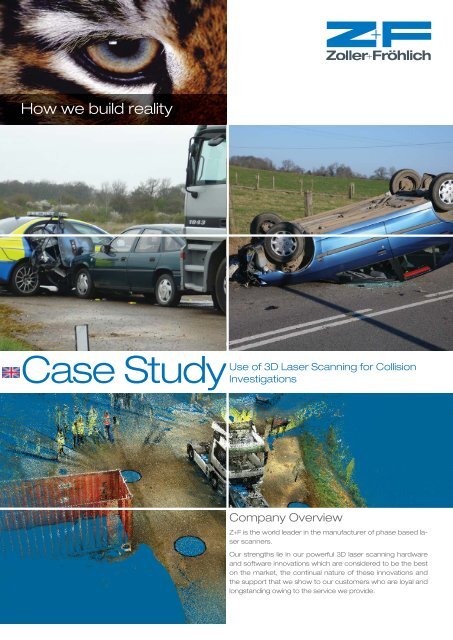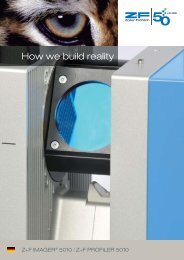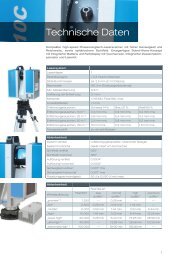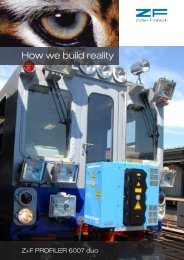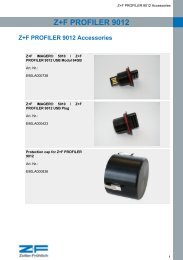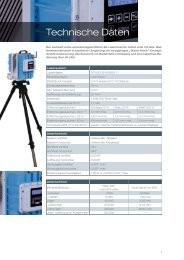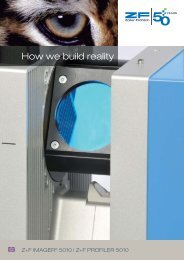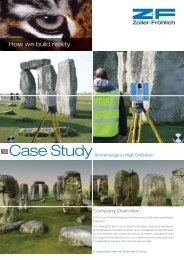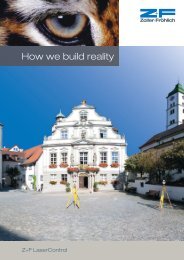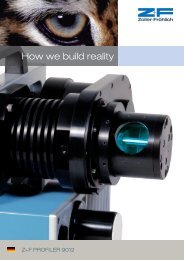Read the case study about accident investigation. - ZF-Laser
Read the case study about accident investigation. - ZF-Laser
Read the case study about accident investigation. - ZF-Laser
You also want an ePaper? Increase the reach of your titles
YUMPU automatically turns print PDFs into web optimized ePapers that Google loves.
How we build reality<br />
Case Study<br />
Use of 3D <strong>Laser</strong> Scanning for Collision<br />
Investigations<br />
Company Overview<br />
Z+F is <strong>the</strong> world leader in <strong>the</strong> manufacturer of phase based laser<br />
scanners.<br />
Our strengths lie in our powerful 3D laser scanning hardware<br />
and software innovations which are considered to be <strong>the</strong> best<br />
on <strong>the</strong> market, <strong>the</strong> continual nature of <strong>the</strong>se innovations and<br />
<strong>the</strong> support that we show to our customers who are loyal and<br />
longstanding owing to <strong>the</strong> service we provide.
Introduction<br />
Collecting data following a collision scene<br />
creates numerous challenges with respect<br />
to accurately documenting <strong>the</strong> scene for future<br />
evaluation.<br />
Many parameters can restrict <strong>the</strong> <strong>investigation</strong>,<br />
not only o<strong>the</strong>r personnel carrying out essential<br />
work, but also <strong>the</strong> added pressure in<br />
re-opening <strong>the</strong> carriage way due to <strong>the</strong> ongoing<br />
cost that occurs to <strong>the</strong> economy.<br />
Injured personnel are <strong>the</strong> obvious priority and<br />
whilst <strong>the</strong>y are paramount it <strong>the</strong>n becomes<br />
important to understand how <strong>the</strong> <strong>accident</strong><br />
occurred. Rapid 3D documentation has proven<br />
to be of great benefit for collission <strong>investigation</strong><br />
purposes.<br />
In this <strong>case</strong> <strong>study</strong> <strong>the</strong> Essex Forensic Collision<br />
Investigation Unit based in Chelmsford<br />
constructed a mock collision scene where<br />
3D laser scanning technology was used to<br />
accurately capture <strong>the</strong> geometry and location<br />
of <strong>the</strong> scene for <strong>the</strong> purposes of digitally<br />
reconstructing <strong>the</strong> <strong>accident</strong>.<br />
3D laser scanner technology from Z+F was<br />
used to scan a collision scene where seven<br />
o<strong>the</strong>r neighbouring Collision Unit Forces were<br />
invited to review <strong>the</strong> process.<br />
2
Dataset of <strong>the</strong> collision scene<br />
Complete coloured datasetof <strong>the</strong> collision scene<br />
3
Methodology<br />
Instruments and Software<br />
The Z+F IMAGER ® 5010 phase based scanner<br />
was used due to its speed and data<br />
capture rate at over 1 million points per<br />
second (See “Spotlight On ...” section).<br />
An optional automatic camera was also<br />
incorporated to capture colour information.<br />
Vast amounts of data were quickly generated<br />
and stored on <strong>the</strong> internal hard drive<br />
of <strong>the</strong> IMAGER ® 5010. The IMAGER series<br />
consists of totally encapsulated scanners<br />
where no peripherals are required to operate.<br />
It was important that <strong>the</strong> scanner was<br />
portable and light due to some of <strong>the</strong> intended<br />
environments it would be operated in.<br />
For capturing <strong>the</strong> scene, multiple scan positions<br />
were required in order to create <strong>the</strong><br />
complete 3D view of <strong>the</strong> collision. The scans<br />
from each position were <strong>the</strong>n aligned, and<br />
extraneous points around <strong>the</strong> scene were<br />
removed, leaving only <strong>the</strong> point cloud of<br />
<strong>the</strong> <strong>accident</strong> scene. These point clouds were<br />
<strong>the</strong>n merged into a database to allow <strong>the</strong><br />
overall project to be viewed and finally exported<br />
into a CAD package for fur<strong>the</strong>r development.<br />
Why was laser scanning chosen<br />
In order to produce exact reconstructions of<br />
collision scenes, <strong>the</strong> data needs to be as accurate<br />
as possible. This serves as <strong>the</strong> basis,<br />
which <strong>the</strong> investigators depend on.<br />
It was <strong>the</strong>refore extremely important that <strong>the</strong><br />
time was used productively and as much data<br />
was captured as possible. Various scanning<br />
solutions have been considered however<br />
4
Capturing <strong>the</strong> collision scene with precise data is essential to<br />
reconstruct <strong>the</strong> scene and to start <strong>the</strong> <strong>investigation</strong>.<br />
Partial View of <strong>the</strong> collision scene for<br />
greater detail.<br />
<strong>the</strong> phased based scanner from Z+F was <strong>the</strong><br />
only scanner to capture critical collision evidence<br />
marks due to its high resolution, rapid<br />
scan rate, portability and overall ease of<br />
operation.<br />
The quality of <strong>the</strong> data produced enables investigators<br />
to conduct computer simulations<br />
based on objective, accurate and digital data,<br />
which speeds up <strong>the</strong> recording of <strong>the</strong> scene<br />
thus enabling normality to be regained to <strong>the</strong><br />
area concerned.<br />
Problems Encountered<br />
Scanning in open environments is uncomplicated<br />
although extremes of wea<strong>the</strong>r can<br />
affect <strong>the</strong> possibility to scan. With improved<br />
IP ratings <strong>Laser</strong>scanning can also be employed<br />
in <strong>the</strong>se conditions. Difficulties arose<br />
where heavy rain occured.<br />
In <strong>the</strong> field, <strong>the</strong> challenges faced can be environment<br />
related, for example collision scenes<br />
are offen in difficult environments far away<br />
from local towns or villages. Among o<strong>the</strong>rs,<br />
temperature, rugged landscapes, and availability<br />
of power were at <strong>the</strong> forefront of <strong>the</strong><br />
Collision Investigators concerns. Thankfully,<br />
<strong>the</strong> new Z+F IMAGER ® 5010 with one of<br />
<strong>the</strong> best overall temperature ratings available<br />
was portable enough to be carried over<br />
any terrain without much trouble. The integral<br />
battery packs provided plenty of power for a<br />
full day’s scanning.<br />
5
Deliverables<br />
The IMAGER ® 5010 supplied 3D scans in point<br />
cloud format compatible with most 3D CAD<br />
packages, allowing <strong>the</strong> Collision Investigators<br />
to import <strong>the</strong> data into whatever software environment<br />
<strong>the</strong>y were most familiar with.<br />
Register software allowed <strong>the</strong> scans to be aligned<br />
with a high level of accuracy, producing<br />
a complete database of <strong>the</strong> collision scenes<br />
composed of multiple point clouds captured<br />
from numerous scan positions.<br />
Conclusion<br />
The mock scene generated significant interest<br />
at this initial event with Collision Investigators<br />
being present from:<br />
- Essex Forensic Collision Investigation Unit<br />
- Sussex Collision Unit<br />
- Kent Forensic Collision Investigation Unit<br />
- Thames Valley Collision Unit<br />
- Hertfordshire Collision Unit<br />
- Bedford Collision Unit<br />
- City Of London Collision Unit.<br />
Fur<strong>the</strong>r demonstrations and evaluations of<br />
collision scenes using 3D laser scanning will<br />
be scheduled, informing Collision Investigators<br />
of technology available to assist <strong>the</strong>m in<br />
<strong>the</strong>ir difficult task of trying to understand how<br />
and why <strong>the</strong> incidents occurred.<br />
6
View of <strong>the</strong> collision scene<br />
Spotlight on IMAGER ® 5010<br />
The Z+F IMAGER ® 5010 sets new standards<br />
in <strong>the</strong> field of 3D laser scanning.<br />
Thanks to its amazing speed and ease of<br />
use, this high-end scanner enables people<br />
to work efficiently and quickly.<br />
The device can operate up to a maximum<br />
range of 187 m, making it a leader in <strong>the</strong> <strong>Laser</strong><br />
Scanning industry.<br />
7
Zoller + Fröhlich GmbH<br />
Simoniusstrasse 22<br />
88239 Wangen im Allgäu<br />
Germany<br />
Phone: +49 7522 9308-0<br />
Fax: +49 7522 9308-252<br />
www.zf-laser.com<br />
info@zf-laser.com<br />
01/2013


